Abstract
Four typing methods for the strain differentiation of Candida albicans (morphotyping, resistotyping, extracellular enzyme production, and carbon source assimilation reactions) were compared on a single population of 100 strains. An index of discriminatory power was used to facilitate this comparison. Extracellular enzyme production had poor discriminatory power, and carbon source assimilation reactions were poorly reproducible. Morphotyping and resistotyping had acceptable reproducibility and discrimination. The use of resistotyping and morphotyping in parallel enhanced discrimination without an unacceptable decrease in reproducibility, although other combinations did not enhance discrimination because reproductibility was impaired.
Full text
PDF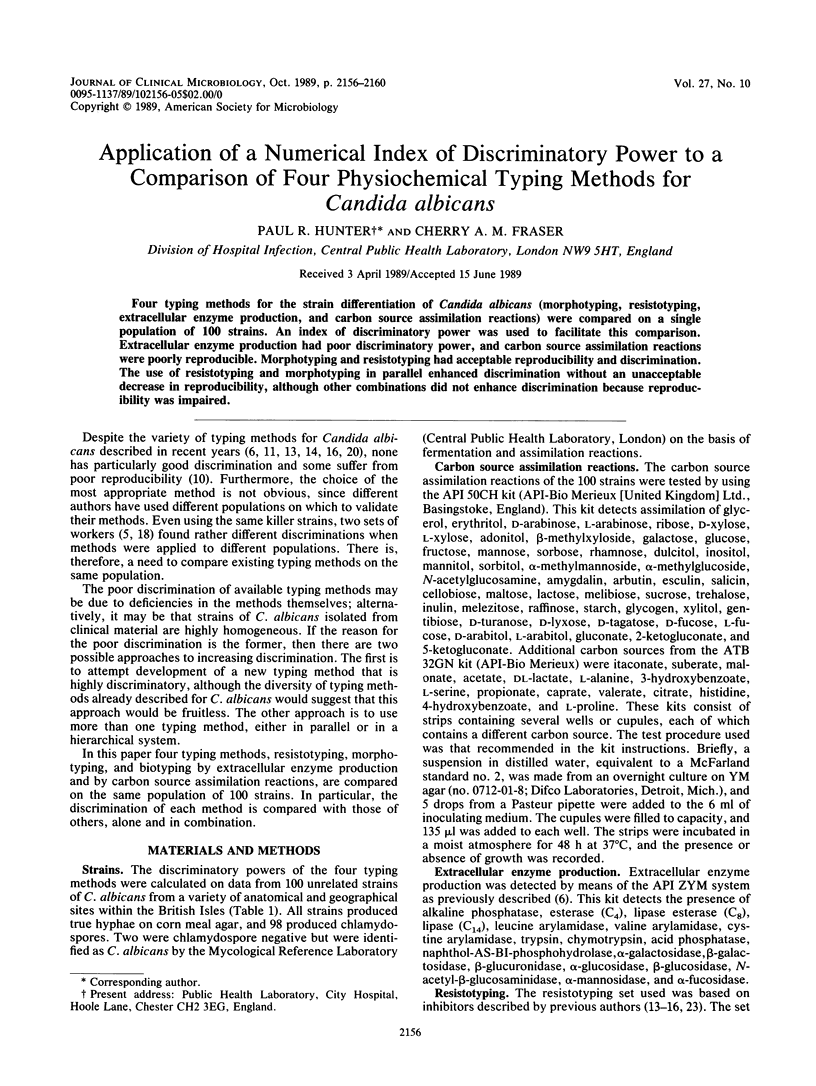
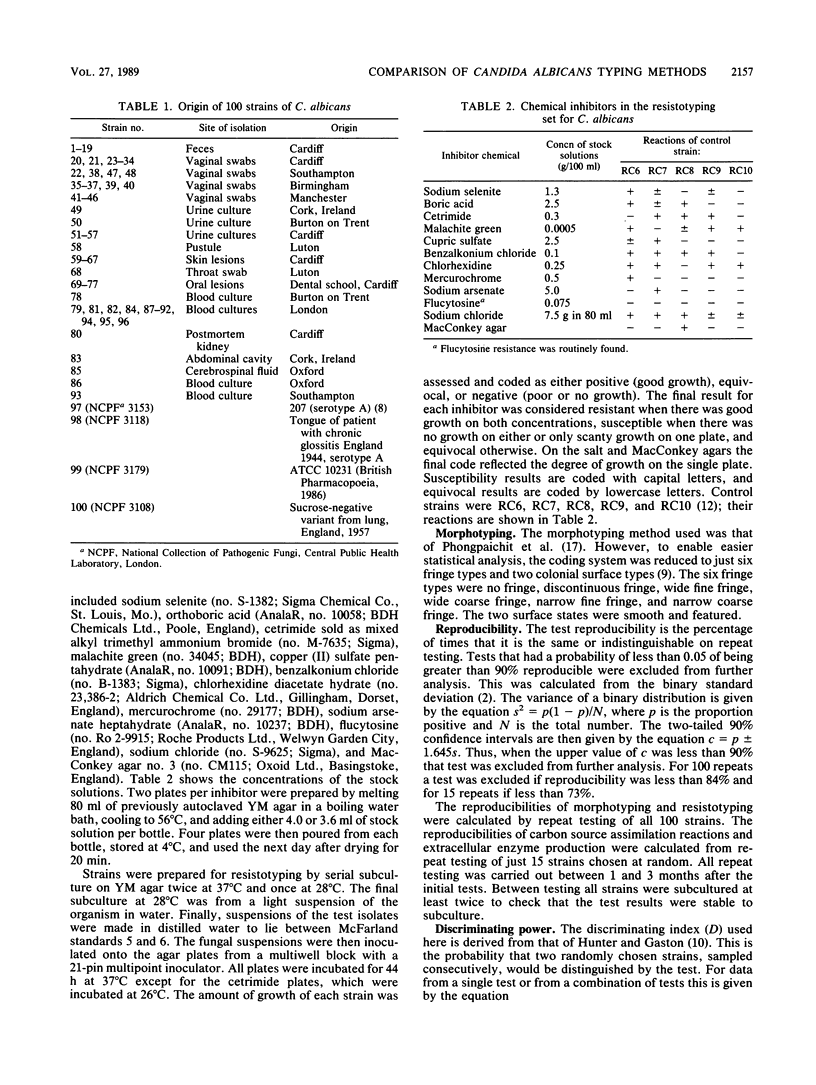
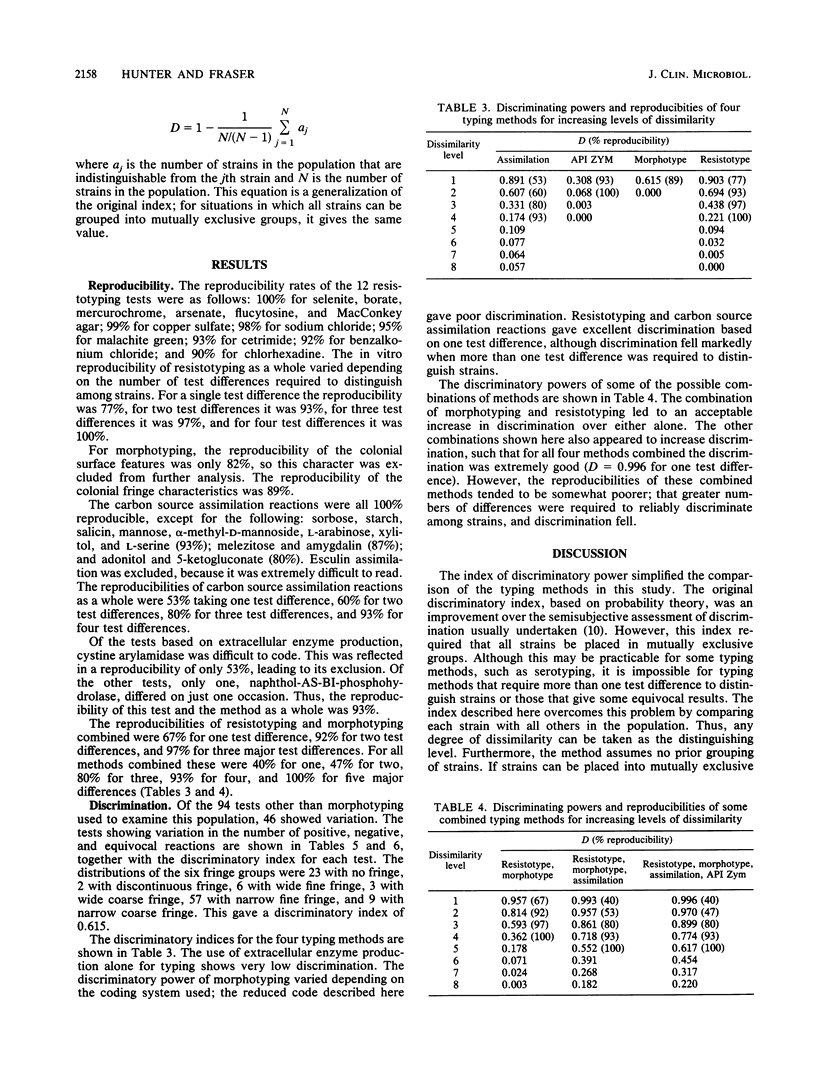
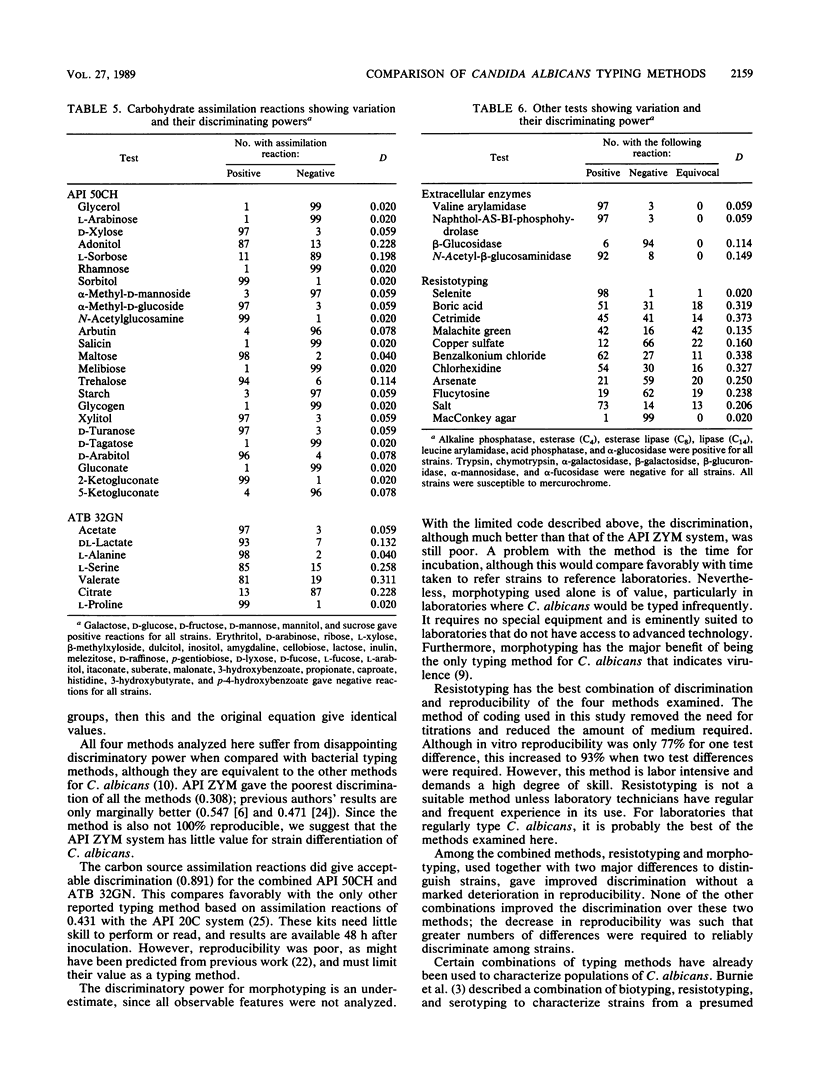
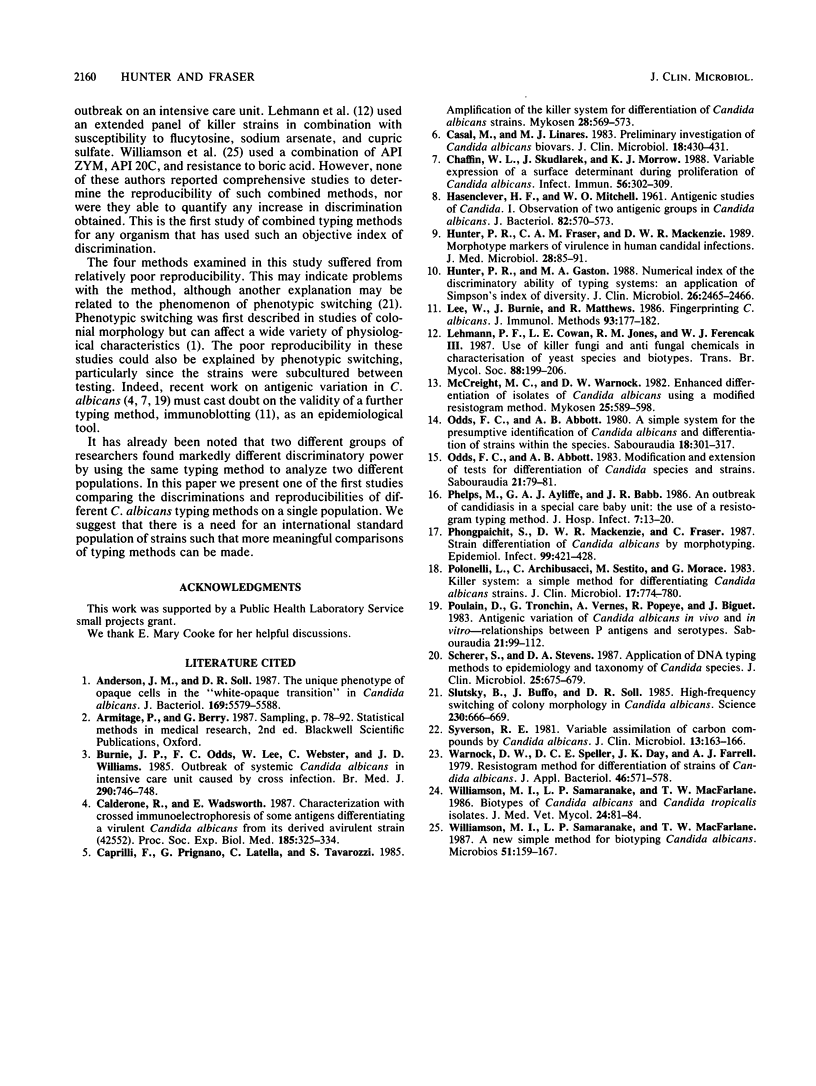
Selected References
These references are in PubMed. This may not be the complete list of references from this article.
- Anderson J. M., Soll D. R. Unique phenotype of opaque cells in the white-opaque transition of Candida albicans. J Bacteriol. 1987 Dec;169(12):5579–5588. doi: 10.1128/jb.169.12.5579-5588.1987. [DOI] [PMC free article] [PubMed] [Google Scholar]
- Burnie J. P., Odds F. C., Lee W., Webster C., Williams J. D. Outbreak of systemic Candida albicans in intensive care unit caused by cross infection. Br Med J (Clin Res Ed) 1985 Mar 9;290(6470):746–748. doi: 10.1136/bmj.290.6470.746. [DOI] [PMC free article] [PubMed] [Google Scholar]
- Calderone R., Wadsworth E. Characterization with crossed immunoelectrophoresis of some antigens differentiating a virulent Candida albicans from its derived, avirulent strain. Proc Soc Exp Biol Med. 1987 Jul;185(3):325–334. doi: 10.3181/00379727-185-42552. [DOI] [PubMed] [Google Scholar]
- Caprilli F., Prignano G., Latella C., Tavarozzi S. Amplification of the killer system for differentiation of Candida albicans strains. Mykosen. 1985 Nov;28(11):569–573. doi: 10.1111/j.1439-0507.1985.tb02088.x. [DOI] [PubMed] [Google Scholar]
- Chaffin W. L., Skudlarek J., Morrow K. J. Variable expression of a surface determinant during proliferation of Candida albicans. Infect Immun. 1988 Feb;56(2):302–309. doi: 10.1128/iai.56.2.302-309.1988. [DOI] [PMC free article] [PubMed] [Google Scholar]
- HASENCLEVER H. F., MITCHELL W. O. Antigenic studies of Candida. I. Observation of two antigenic groups in Candida albicans. J Bacteriol. 1961 Oct;82:570–573. doi: 10.1128/jb.82.4.570-573.1961. [DOI] [PMC free article] [PubMed] [Google Scholar]
- Hunter P. R., Fraser C. A., Mackenzie D. W. Morphotype markers of virulence in human candidal infections. J Med Microbiol. 1989 Feb;28(2):85–91. doi: 10.1099/00222615-28-2-85. [DOI] [PubMed] [Google Scholar]
- Hunter P. R., Gaston M. A. Numerical index of the discriminatory ability of typing systems: an application of Simpson's index of diversity. J Clin Microbiol. 1988 Nov;26(11):2465–2466. doi: 10.1128/jcm.26.11.2465-2466.1988. [DOI] [PMC free article] [PubMed] [Google Scholar]
- Lee W., Burnie J., Matthews R. Fingerprinting Candida albicans. J Immunol Methods. 1986 Nov 6;93(2):177–182. doi: 10.1016/0022-1759(86)90186-9. [DOI] [PubMed] [Google Scholar]
- McCreight M. C., Warnock D. W. Enhanced differentiation of isolates of Candida albicans using a modified resistogram method. Mykosen. 1982 Nov;25(11):589–598. doi: 10.1111/j.1439-0507.1982.tb01926.x. [DOI] [PubMed] [Google Scholar]
- Odds F. C., Abbott A. B. A simple system for the presumptive identification of Candida albicans and differentiation of strains within the species. Sabouraudia. 1980 Dec;18(4):301–317. [PubMed] [Google Scholar]
- Odds F. C., Abbott A. B. Modification and extension of tests for differentiation of Candida species and strains. Sabouraudia. 1983 Mar;21(1):79–81. doi: 10.1080/00362178385380111. [DOI] [PubMed] [Google Scholar]
- Phelps M., Ayliffe G. A., Babb J. R. An outbreak of candidiasis in a special care baby unit: the use of a resistogram typing method. J Hosp Infect. 1986 Jan;7(1):13–20. doi: 10.1016/0195-6701(86)90021-6. [DOI] [PubMed] [Google Scholar]
- Phongpaichit S., Mackenzie D. W., Fraser C. Strain differentiation of Candida albicans by morphotyping. Epidemiol Infect. 1987 Oct;99(2):421–428. doi: 10.1017/s0950268800067911. [DOI] [PMC free article] [PubMed] [Google Scholar]
- Polonelli L., Archibusacci C., Sestito M., Morace G. Killer system: a simple method for differentiating Candida albicans strains. J Clin Microbiol. 1983 May;17(5):774–780. doi: 10.1128/jcm.17.5.774-780.1983. [DOI] [PMC free article] [PubMed] [Google Scholar]
- Poulain D., Tronchin G., Vernes A., Popeye R., Biguet J. Antigenic variations of Candida albicans in vivo and in vitro--relationships between P antigens and serotypes. Sabouraudia. 1983 Jun;21(2):99–112. [PubMed] [Google Scholar]
- Román M. C., Linares Sicilia M. J. Preliminary investigation of Candida albicans biovars. J Clin Microbiol. 1983 Aug;18(2):430–431. doi: 10.1128/jcm.18.2.430-431.1983. [DOI] [PMC free article] [PubMed] [Google Scholar]
- Scherer S., Stevens D. A. Application of DNA typing methods to epidemiology and taxonomy of Candida species. J Clin Microbiol. 1987 Apr;25(4):675–679. doi: 10.1128/jcm.25.4.675-679.1987. [DOI] [PMC free article] [PubMed] [Google Scholar]
- Slutsky B., Buffo J., Soll D. R. High-frequency switching of colony morphology in Candida albicans. Science. 1985 Nov 8;230(4726):666–669. doi: 10.1126/science.3901258. [DOI] [PubMed] [Google Scholar]
- Syverson R. E. Variable assimilation of carbon compounds by Candida albicans. J Clin Microbiol. 1981 Jan;13(1):163–166. doi: 10.1128/jcm.13.1.163-166.1981. [DOI] [PMC free article] [PubMed] [Google Scholar]
- Warnock D. W., Speller D. C., Day J. K., Farrell A. J. Resistogram method for differentiation of strains of Candida albicans. J Appl Bacteriol. 1979 Jun;46(3):571–578. doi: 10.1111/j.1365-2672.1979.tb00857.x. [DOI] [PubMed] [Google Scholar]
- Williamson M. I., Samaranayake L. P., MacFarlane T. W. A new simple method for biotyping Candida albicans. Microbios. 1987;51(208-209):159–167. [PubMed] [Google Scholar]
- Williamson M. I., Samaranayake L. P., MacFarlane T. W. Biotypes of oral Candida albicans and Candida tropicalis isolates. J Med Vet Mycol. 1986 Feb;24(1):81–84. [PubMed] [Google Scholar]


